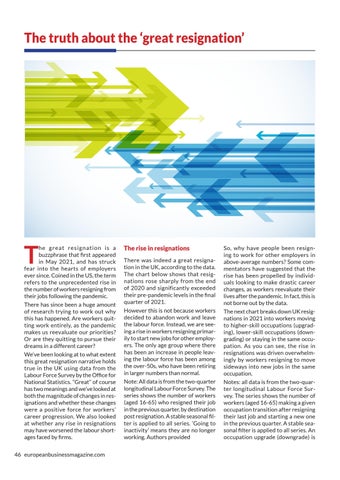The truth about the ‘great resignation’
T
he great resignation is a buzzphrase that first appeared in May 2021, and has struck fear into the hearts of employers ever since. Coined in the US, the term refers to the unprecedented rise in the number of workers resigning from their jobs following the pandemic. There has since been a huge amount of research trying to work out why this has happened. Are workers quitting work entirely, as the pandemic makes us reevaluate our priorities? Or are they quitting to pursue their dreams in a different career? We’ve been looking at to what extent this great resignation narrative holds true in the UK using data from the Labour Force Survey by the Office for National Statistics. “Great” of course has two meanings and we’ve looked at both the magnitude of changes in resignations and whether these changes were a positive force for workers’ career progression. We also looked at whether any rise in resignations may have worsened the labour shortages faced by firms.
46 europeanbusinessmagazine.com
The rise in resignations There was indeed a great resignation in the UK, according to the data. The chart below shows that resignations rose sharply from the end of 2020 and significantly exceeded their pre-pandemic levels in the final quarter of 2021. However this is not because workers decided to abandon work and leave the labour force. Instead, we are seeing a rise in workers resigning primarily to start new jobs for other employers. The only age group where there has been an increase in people leaving the labour force has been among the over-50s, who have been retiring in larger numbers than normal. Note: All data is from the two-quarter longitudinal Labour Force Survey. The series shows the number of workers (aged 16-65) who resigned their job in the previous quarter, by destination post resignation. A stable seasonal filter is applied to all series. ‘Going to inactivity’ means they are no longer working. Authors provided
So, why have people been resigning to work for other employers in above-average numbers? Some commentators have suggested that the rise has been propelled by individuals looking to make drastic career changes, as workers reevaluate their lives after the pandemic. In fact, this is not borne out by the data. The next chart breaks down UK resignations in 2021 into workers moving to higher-skill occupations (upgrading), lower-skill occupations (downgrading) or staying in the same occupation. As you can see, the rise in resignations was driven overwhelmingly by workers resigning to move sideways into new jobs in the same occupation. Notes: all data is from the two-quarter longitudinal Labour Force Survey. The series shows the number of workers (aged 16-65) making a given occupation transition after resigning their last job and starting a new one in the previous quarter. A stable seasonal filter is applied to all series. An occupation upgrade (downgrade) is
























